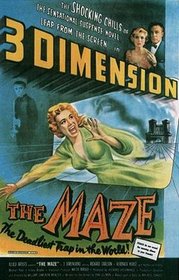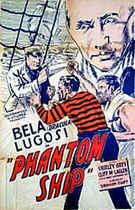Our editor-in-chief Nate Yapp is proud to have contributed to the new book Hidden Horror: A Celebration of 101 Underrated and Overlooked Fright Flicks, edited by Aaron Christensen. Another contributors include Anthony Timpone, B.J. Colangelo, Dave Alexander, Classic-Horror.com's own Robert C. Ring and John W. Bowen. Pick up a copy today from Amazon.com!
The Maze (1953)
Every so often, you stumble across a film you’ve only read about, but were never able to see previously. After studying tantalizing stills and poster art, the anticipation builds. When at last the day comes that you are finally able to see it, the inevitable letdown occurs. We’ve all experienced it. Ever since my purchase of William K. Everson’s Classics of the Horror Film as a thirteen-year-old, that still of Veronica Hurst and Katherine Emery standing alone in the courtyard of a crumbling Scottish castle haunted me. That picture, from 1953's The Maze, stayed with me for years, creating images and ideas in my head, forming a Gothic nightmare that only a classic horror fan can know or appreciate. Recently, I came across a copy of the movie. With breathless excitement I inserted the DVD. What followed was more than just disappointment; it was a feeling of viewing a missed opportunity, of a great concept let down by budget restraints and by the visual effects of the time.
Kitty Murray (Veronica Hurst) is elated. Her engagement to the dashing Gerald McTeam (Richard Carlson) has her walking on air. Her excitement is put on hold, however, when Gerald receives a mysterious cable summoning him to claim his inheritance. After promising to return soon, Gerald departs for Scotland. As the days become weeks without any further contact, Kitty becomes more and more concerned that something may be wrong. Accompanied by her stern but loving aunt (Katherine Emery), they arrive at the Old Dark Castle, only to be told by the disaffected butler that Gerald will not see them. After forcing her way into the manor, she finally sees her fiancée and she is startled by his appearance. His face is drawn, his hair white. Gerald becomes agitated and orders her to leave. Kitty is determined to get to the bottom of things, whether Gerald likes it or not.
Directed by the great art director and set designer William Cameron Menzies, the film has an authentic gothic look and feel, echoing the decrepit manses of past haunted house epics like Paul Leni’s The Cat and the Canary and Joe May’s The House of Fear, with its long hallways, high ceilings, and cobwebbed passages. Menzies and cinematographer Harry Neumann provide the film with some beautiful tracking shots of the castle and its grounds, slathering the sets with a thick blanket of fog. Menzies use of the evocative score by Marlin Skiles helps to weave a web of mystery around the film. The score is quite unlike the brassy, overbearing ones Skiles usually provided for such Bowery Boys fare as Dig That Uranium and Hold That Hypnotist. His use of woodwinds for the castle’s “theme” creates the proper sense of dread.
Originally shot in the fad of the day, 3D, Menzies steers clear of most of the clichés associated with the format. In fact, when watching it in standard 2D, as this reviewer did, one would be hard-pressed to identify it as having been a 3-dimensional feature. Eschewing other 3D gimmicks (the paddle ball in House of Wax; the thrusting spears of Treasure of the Four Crowns), Menzies utilizes the depth of his sets and his most visually striking design, the giant hedge maze of the title. Foreshadowing the more elaborate set of the Stanley Kubrick classic, The Shining, the maze is used almost too sparingly. The climactic scene of Kitty and her aunt pursuing Gerald and his secret through the door of the maze is the best in the picture, creating a palpable sense of dread. The sequence is a moody, shadowy mini-masterpiece, with Gerald and his servants accompanying the mutated lord down stairs to the maze. With candlelight their only illumination, Kitty and her aunt creep along the walls of the maze, hearing more of the same wet, shambling sounds they’d heard earlier.
The actors are unusually competent for a low-budget horror film. Richard Carlson gives Gerald’s problems real weight, his eyes conveying the overwhelming cost of his burden. Miss Hurst shows real moxie and spunk, lifting her above most horror heroine roles. She’s not a victim, and she won’t let herself be made into one. Her final confrontation with Carlson rings true, with the starcrossed couple in a standoff and neither willing to budge. The feeling of a romance slipping away is achingly portrayed and adds a note of Shakesperean tragedy to the latter half of the film.
To be frank, The Maze is frustrating because so many of the elements that go together to make this film ARE above average. So why is it such a frustrating experience to watch?
The first problem is pacing. Scenes tend to have little or no momentum. The few scenes that work are ended before there is any payoff at all. There is a bit of repetition as Kitty and her aunt take turns waking in the middle of the night to strange sounds outside their doors. When they try to investigate, they are stymied by Gerald or his servants. This happens several times, with little or nothing to learned as to the source of the creepy, moist sounds. The only thing Kitty discovers is that the true lord of the manor is upstairs, with a food bowl outside his door. A brief scene of Gerald leading his servants and…something…to the enormous hedge maze outside by candlelight is somber and haunting, but amounts to little. Kitty invites some mutual friends hoping to jar Gerald out of his funk, but he remains sullen and distant. There is much dialog, most of it dull and tedious, relating action we’ve already seen. At this point, the audience begins to squirm, not from uneasy anticipation or excitement, but from boredom and apathy.
The other chink in the film’s armor (and the most damaging) is the film’s ludicrous ending. Unlike most reviewers, my problem isn’t the sheer goofiness of it, but that special effects of the time let down Dan Ullman’s screenplay. The secret of the ancient lord of the manor is Lovecraftian in nature, and here is the crux of the problem. Had this film been made in 2009, the technical wizardry of modern special effects could have created a horrifying image, one that could truly epitomize the stomach-churning abomination Ullman must have envisioned. The cursed lord should have been a creature that inspired pity as well as revulsion. However, the large bullfrog that Menzies photographed against a miniature set has caused peals of laughter to erupt from audiences primed for shock. To that end, the overall tone of seriousness and gravity seems hysterically overplayed.
As someone who prefers the mood and atmospherics of the old black-and-white horror and mystery thrillers, it’s rare that I would actually anticipate *shudder* a remake. The limits of 1950’s low-budget effects, however, cry out for a director of the caliber of Alex Proyas or Guillermo del Toro to remake this story with a modern sensibility. Not with an increase in gore or body count, mind you, but the ability to fashion a creature worthy of the build-up, taking its cue from similar atrocities in Lovecraft’s “The Beast in the Cave” and “Herbert West: Re-Animator”.
Sometimes, the film you read about so long ago is impossible for the real thing to live up to. In the case of The Maze, disappointment is inevitable. What you’re left with is some pretty pictures and a shaggy dog (or in this case, a slippery frog) story that goes nowhere.









I think this is one of those
I think this is one of those films for which there is no substitute for being a child and, furthermore, a child of the times. The movie and I made our appearance in the same year. I probably saw it in 1962, on TV, and it scared the bejeezus outta me. A nine-year-old who never was exposed to any sort of sophisticated SFX was down with the ending, and even experienced that pity the writer aimed for.
My son and I cried and felt
My son and I cried and felt sorry for the old lord. Two hundred years! Imagine having a family member who was that old and still around---how I would have protected him.
We both loathed Kitty from the top of her uber-ladylike coiffed head to the bottom of her shoes. What a ghastly, intrusive little pain in the neck. Can't think why Gerald married her after learning what a rude, entitled little beast she was.
This movie must have been
This movie must have been inspired by this possibly true legend:
https://allkindsofhistory.wordpress.com/2012/02/11/the-monster-of-glamis...